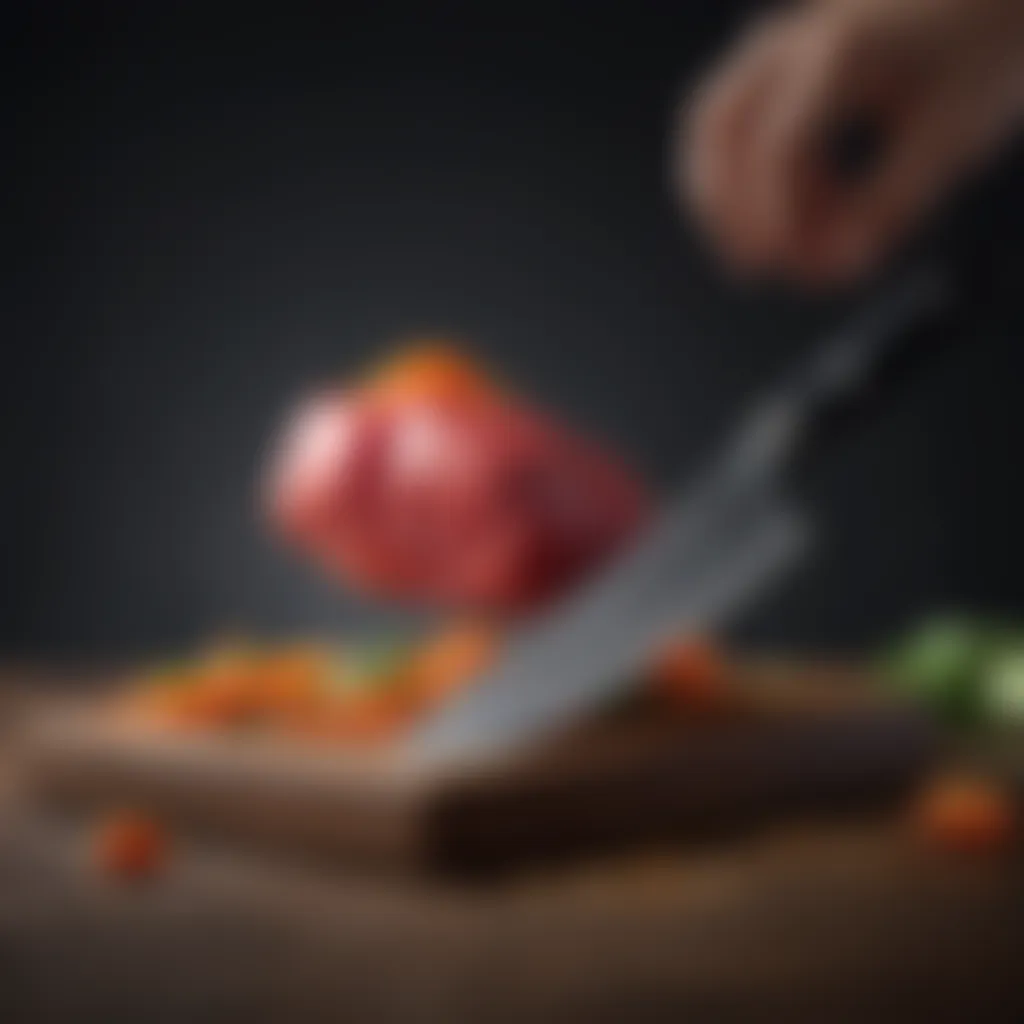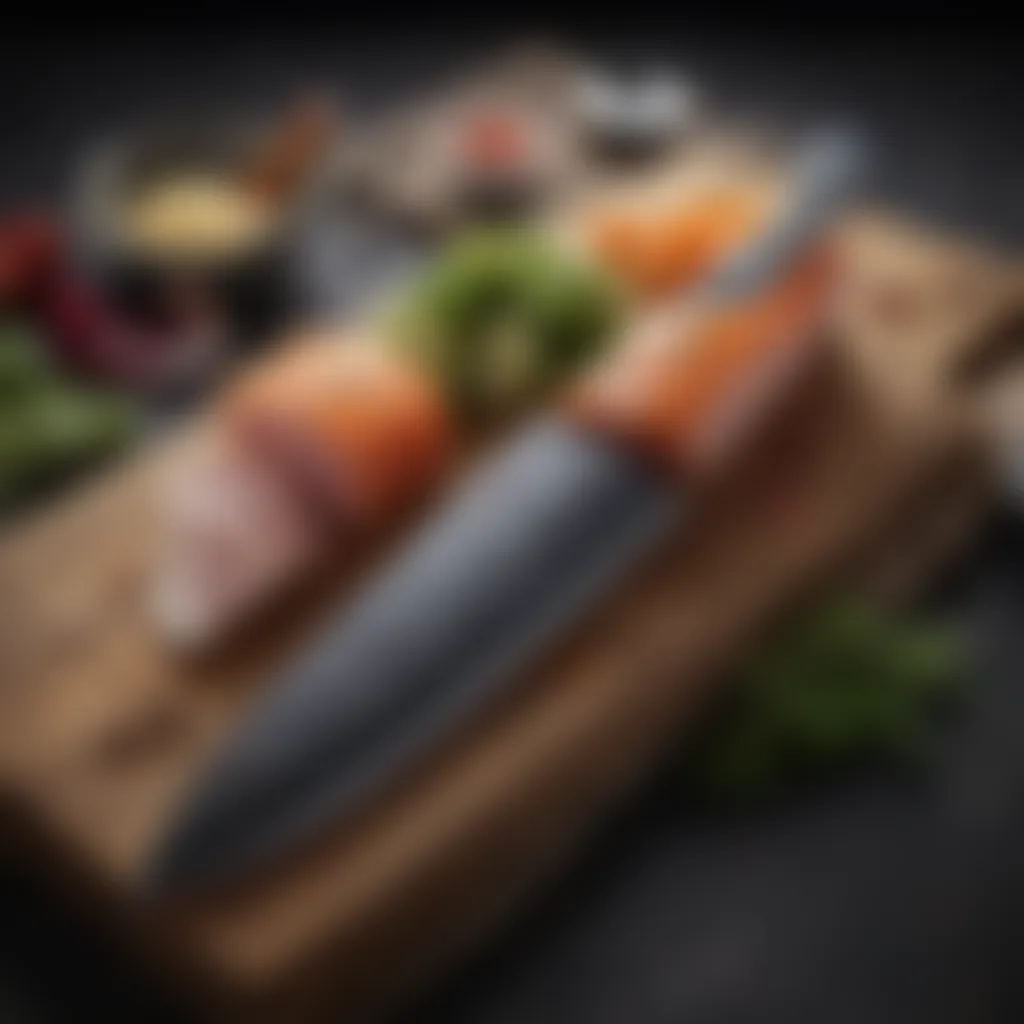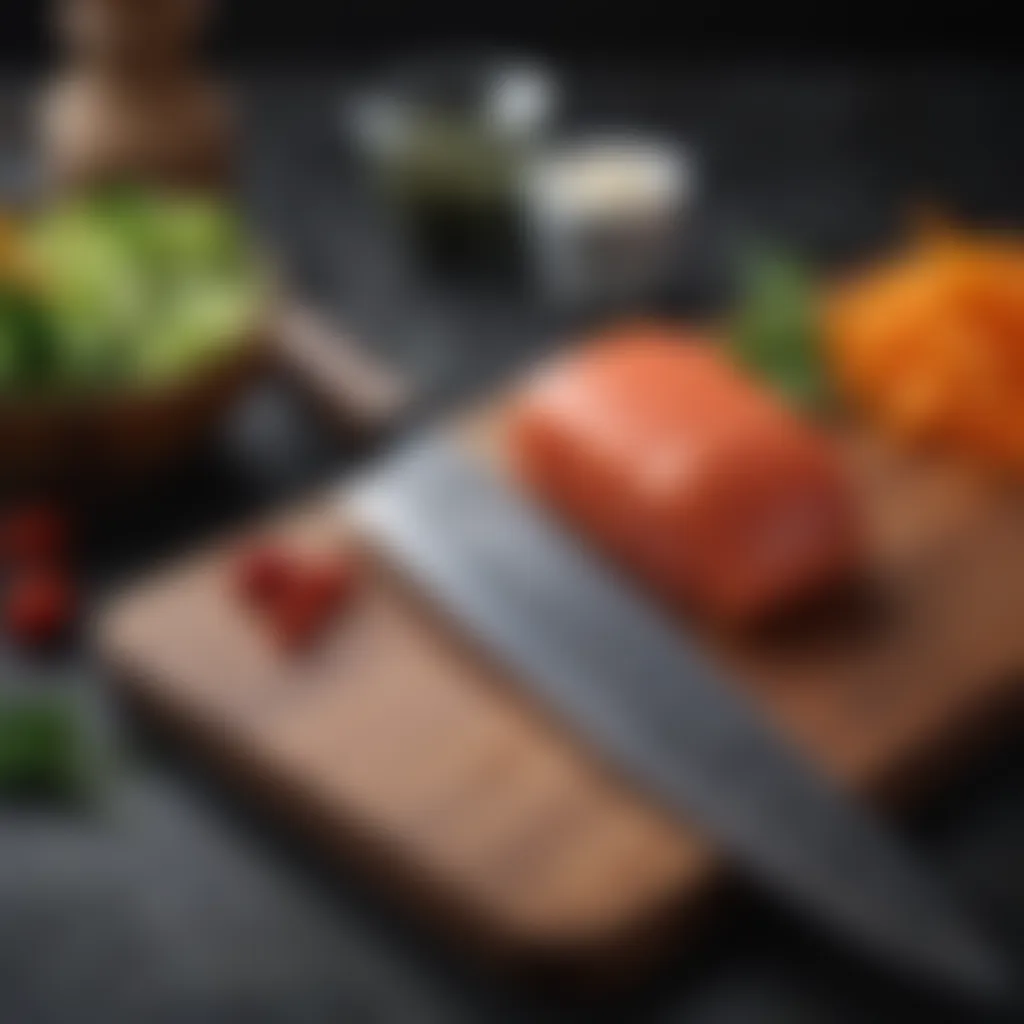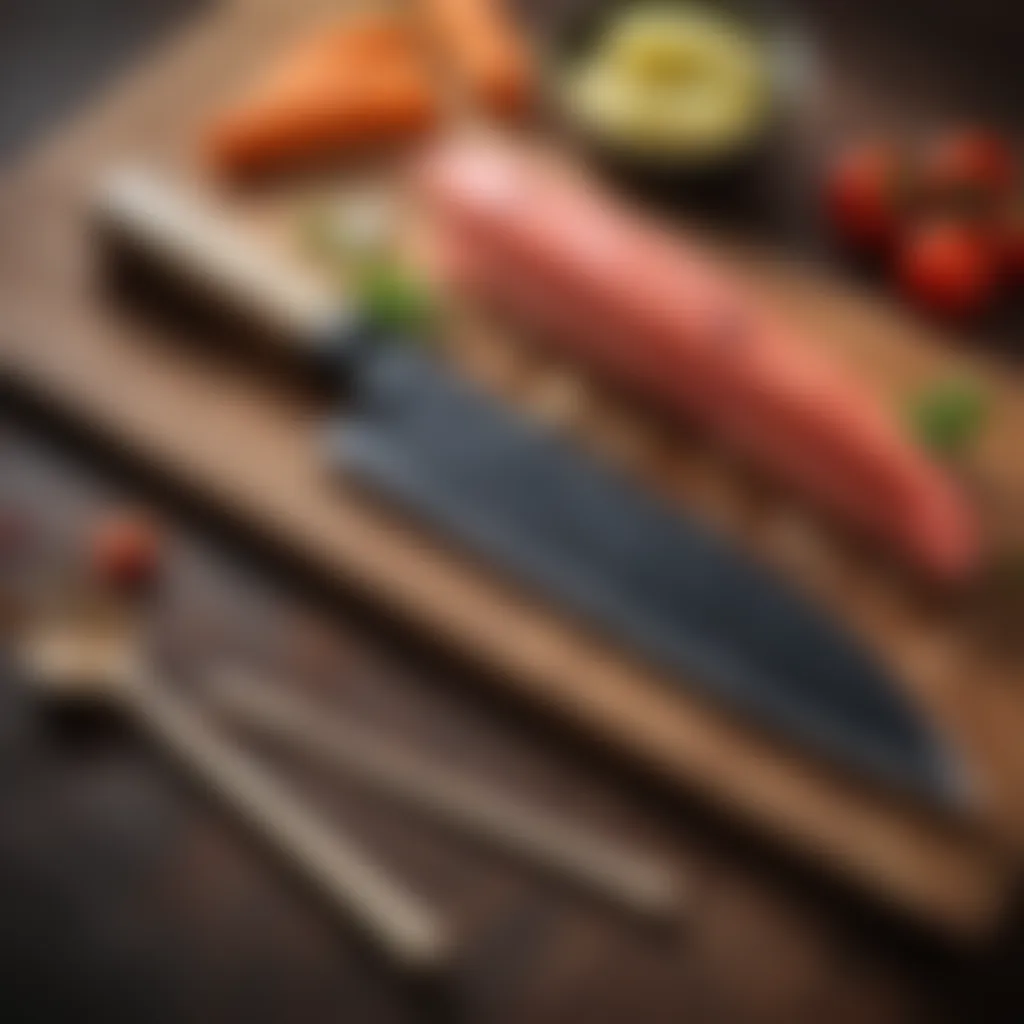Exploring the 7 Inch Japanese Chef Knife


Intro
The 7 inch Japanese chef knife is a remarkable tool in the world of culinary arts. Known for its balance of precision and versatility, this knife captures the essence of Japanese craftsmanship. It serves as an extension of the chef’s hand, making food preparation more intuitive. Chefs admire it for its sharpness and ability to perform tasks from slicing meat to chopping vegetables with efficiency.
In the following sections, we will explore the significance of this knife. We will discuss its design, functionality, maintenance, and compare it with other knife sizes. Understanding these details will enable you to appreciate why it is a favored choice among culinary professionals. Furthermore, we will provide insights into selecting a model that suits your cooking style, and ensure that you can effectively use and maintain it over time.
Preface to the Japanese Chef Knife
The Japanese chef knife is not just a tool in the kitchen; it represents a fusion of craftsmanship, history, and functionality. A well-designed knife enhances the cooking experience, providing balance and precision that is crucial for various culinary tasks. Understanding what defines a Japanese chef knife, particularly the 7-inch variant, is essential for anyone who wishes to elevate their cooking methods and enjoyment. This size strikes a balance between maneuverability and sufficient blade length, making it a versatile choice for home cooks and professionals alike.
Adopting a Japanese chef knife means embracing a tradition steeped in artistry. The meticulous attention to detail not only ensures performance but also brings aesthetic pleasure to the culinary environment. This article will provide insights on the defining characteristics of the Japanese chef knife, its historical significance, and why the 7-inch blade is esteemed in kitchens across the world.
Defining the Japanese Chef Knife
The Japanese chef knife, also known as a "gyuto," serves multiple functions, from slicing vegetables to chopping meat. Its design features a thinner blade compared to Western knives, allowing for enhanced precision. A distinguishing aspect is the symmetrical grind, which enables both right- and left-handed users to maintain control. The typical blade length ranges from 7 to 10 inches, with the 7-inch option favored for its adaptability.
Furthermore, the curvature at the tip facilitates rocking motions during slicing, adding efficiency to chopping tasks. The layering of the steel used provides strength and sharpness, yielding a powerful tool that cuts through various ingredients effortlessly. A well-crafted Japanese chef knife delivers outstanding results, whether for intricate tasks or basic meal preparation.
Historical Context
The roots of the Japanese chef knife trace back centuries, reflecting a tradition of sword-making that has evolved into culinary craftsmanship. The art of knife making began during the Heian period, where techniques and designs were influenced by the samurai culture. Each region in Japan developed its own unique styles and materials, resulting in a rich and diverse heritage in blade-making.
With the arrival of Western culinary practices in the 19th century, Japanese knife makers began to adapt and innovate. The introduction of new steels and manufacturing methods helped to refine the knives further. While the essential characteristics of Japanese knives remain intact, modern advancements have made them more accessible to homes worldwide.
This historical perspective underlines the knife's significance not only as a tool but also as an emblem of culture and tradition. When using a Japanese chef knife, one engages with centuries of skilled craftsmanship that prioritize quality and functionality.
Understanding Knife Dimensions and Their Importance
Understanding knife dimensions is crucial when selecting the right tool for culinary tasks. The size of a knife influences its balance, control, and overall cutting efficiency. For those cooking regularly, grasping these dimensions enhances both safety and effectiveness while preparing food.
The 7 inch blade of a Japanese chef knife offers a sweet spot for various cutting techniques. It combines the maneuverability of smaller knives with the versatility of larger blades. This dimension allows for intricate work, such as slicing vegetables, while still handling larger cuts of meat or fish proficiently. When one understands knife dimensions, it leads to informed choices that facilitate a smoother cooking experience.
The Characteristics of a Inch Blade
A 7 inch blade strikes a balance between length and usability. This blade size is perfect for numerous tasks from chopping to mincing. When using a 7 inch blade, it provides sufficient surface area, which makes it effective for slicing through various ingredients.
Additionally, the design generally features a thin profile, which aids in precision. Chefs often favor the 7 inch blade because it is light yet sturdy. This allows for extended periods of use without fatigue. The curved edge is also worth noting; it helps in the rocking motion needed for efficient chopping.
Comparison with Other Blade Sizes
Comparing the 7 inch knife to others can help in discerning its advantages in everyday cooking.
Inch Knife
The 5 inch knife is compact and nimble. It works well in detailed tasks like peeling or precise slicing. Its lightweight nature is a significant aspect, making it popular among beginner cooks. However, its shorter length limits its effectiveness with larger items. Thus, while useful, it may not replace the need for a versatile 7 inch knife often favored in professional settings.
Inch Knife
The 8 inch knife offers a bit more length, which can be advantageous for larger dishes or thicker cuts of meat. It is very popular among chefs for its ability to handle diverse cutting tasks. However, its size can lead to awkwardness for those with smaller hands. The increased weight can also cause fatigue in prolonged use. Therefore, while beneficial, it may not suit everyone like the 7 inch blade would.
Inch Knife
The 10 inch knife is typically reserved for serious culinary work needing power and speed. It excels in cutting large pieces of meat or for heavy-duty jobs in the kitchen. The key characteristic of this knife is its substantial weight and reach. However, for home cooks, it may be cumbersome during daily tasks. Hence, it serves its purpose well, but often the 7 inch knife is a more manageable and balanced option for most users.
Craftsmanship and Material Selection
Craftsmanship and material selection play a crucial role in creating high-quality Japanese chef knives. The skill of the artisans and the quality of materials used directly affect the knife's sharpness, durability, and overall performance. When one seeks a functional and aesthetically pleasing tool like the 7-inch Japanese chef knife, understanding the craftsmanship and the materials is essential.


Types of Steel Used in Japanese Knives
Japanese knives are known for their use of high-quality steel. Different types of steel lend various characteristics to the blade, each offering unique advantages.
VG-10
VG-10 steel is a type of stainless steel favored for its ability to maintain sharpness while being resistant to corrosion. It contains vanadium, which increases the hardness and sharpness of the blade. The key characteristic of VG-10 is its superior edge retention, which is particularly useful in a busy kitchen environment. This makes it a popular choice among both professionals and home cooks.
Its unique feature is that it is often layered with softer steel to create a Damascus pattern. This not only enhances its aesthetic appeal but also combines strength and flexibility. However, VG-10 can be more expensive than other types of steel. Its longevity and performance often justify the price.
Blue Steel
Blue Steel, similar to VG-10, is known for its excellent edge retention and ability to achieve a sharp edge. What sets Blue Steel apart is the incorporation of chromium, which provides some level of corrosion resistance while maintaining sharpenability. The key characteristic here is its toughness, making it suitable for heavy-duty knife work.
A unique feature of Blue Steel is its ability to develop a patina, which can add character over time. This steel is favored among traditionalists who appreciate the bond between the knife and its user. However, it can demand more maintenance to prevent rusting compared to VG-10.
White Steel
White Steel is often considered the staple of Japanese cutlery. It is characterized by its purity and simplicity, containing little to no alloying elements. This results in a very hard blade that can be sharpened to razor-like sharpness. The key benefit of White Steel is its ease of honing and ability to take and hold a fine edge.
Its unique feature lies in its performance; however, it tends to be reactive and requires diligent care to avoid rust. Home cooks might find this maintenance demanding, but for those who understand its needs, White Steel can offer exceptional performance.
The Role of Forging Techniques
The method of forging a knife significantly influences its final qualities. Different techniques not only shape the blade but also affect its durability and performance.
Hand Forging
Hand forging is an age-old technique where artisans manually shape the blade. This method ensures that each knife is unique and exhibits exceptional balance and control. A key characteristic of hand-forged knives is their superior craftsmanship, which comes from the attention to detail and skill of the artisan.
Each hand-forged knife retains a distinct personality, making them special for chefs and home cooks alike. However, the labor-intensive process typically results in higher prices compared to machine-forged options.
Machine Forging
Machine forging relies on advanced technology to produce knives with consistent quality and performance. It offers precision that can be hard to achieve by hand alone. The key feature of machine-forged knives is their uniformity; each knife is produced to exact specifications, ensuring reliability in performance.
While machine-forged knives may lack the unique character of hand-forged options, they often come at a lower price point, making them accessible for many kitchens. However, they might not offer the same level of finesse as their hand-forged counterparts.
Stamping
The stamping technique involves cutting knives from a larger sheet of steel. This method is efficient and results in lightweight blades that are easy to handle. The key characteristic of stamped knives is their affordability and practicality for everyday use.
A unique feature of stamped knives is that they can still be produced in various styles aimed at everyday culinary tasks. However, they tend to be less robust than hand-forged or machine-forged knives, which can lead to less durability over time.
Ergonomics and Design Elements
Understanding ergonomics and design elements is vital for anyone looking to refine their culinary skills, especially with a tool as essential as the 7 inch Japanese chef knife. The right design influences a cook's comfort and efficiency in the kitchen. A well-designed knife can enhance performance and reduce fatigue during extended use. Factors like handle shape, weight distribution, and overall balance all contribute significantly to how effectively the knife operates.
Handle Materials and Design
Wood
Wooden handles are well-regarded for their classic appeal and practical benefits. They provide a pleasant grip, as they can absorb moisture and offer increased friction potential during cutting tasks. One popular choice is the rosewood or ebony varieties, known for their durability and aesthetic qualities. The unique warmth of wood is comforting and provides a traditional feel that many chefs prefer. However, they can be prone to damage from prolonged exposure to water, requiring careful maintenance.
Plastic
Plastic handles are often favored for their durability and ease of maintenance. They are resistant to moisture and easy to clean, making them a practical option in busy kitchens. A key characteristic of plastic is its ability to be molded into various shapes, allowing for more ergonomic designs that fit comfortably in the hand. However, some plastic handles can feel less substantial, which may affect the overall user experience for those who prefer a heavier, more solid grip.
Composite


Composite handles combine materials like wood and plastic to leverage the advantages of both. They often feature a comfortable grip with a polished finish and are designed to resist moisture better than pure wood. Composite materials can also provide a more consistent feel and look than traditional wood options. While they are typically very durable, they can be more expensive compared to other handle types.
Balancing Weight and Control
Finding the right balance between weight and control is critical for effective use of a 7 inch Japanese chef knife. A well-balanced knife allows for fluid movements and efficient cutting, which is particularly important during long cooking sessions.[1] If a knife is too heavy toward the blade, it can lead to fatigue. Conversely, if it is too light, it might not provide the necessary force for cutting through tougher materials. The ideal knife should feel like an extension of the hand, facilitating precision and comfort without compromising power.
The right balance between handle and blade ensures maximum control during intricate culinary tasks.
Maintenance and Care Guidelines
Maintaining the integrity and performance of your 7 inch Japanese chef knife is crucial for both safety and efficiency in the kitchen. Proper maintenance extends the lifespan of the knife, ensuring that it stays sharp and functional for years. A well-cared-for knife not only performs better but also enhances the joy of cooking. Neglecting maintenance can lead to dull blades and potential damage to the knife, which can affect the quality of your food preparation.
Sharpening Techniques
Whetstones
Whetstones are one of the most respected methods for sharpening Japanese knives, including the 7 inch variant. They allow for precise sharpening, giving the user control over the angle and pressure applied. The key characteristic of whetstones is their versatility; they come in various grits, allowing you to choose one for honing or for restoring a dull edge.
A unique feature of whetstones is their ability to create a finer edge compared to other sharpening methods. However, they require practice to master. Advantages include a longer-lasting sharpness and the ability to shape the blade as desired. On the other hand, the disadvantage is that it can be time-consuming, especially for beginners.
Sharpening Rods
Sharpening rods offer a quick way to maintain your knife's edge, making them a popular choice among home cooks due to their ease of use. The key characteristic of these rods is their portability, allowing for quick touch-ups on the go. They are beneficial for regular maintenance, keeping the edge straight between more thorough sharpenings.
The unique feature is that they can be used on knives that are already sharpened, making them ideal for maintaining an edge in everyday use. Advantages include speed and convenience, while the downside is that they may not restore a very dull edge effectively.
Professional Services
For those who prefer a hassle-free method or lack the confidence to sharpen their knives, professional sharpening services are a favorable option. The key characteristic is expertise; professionals know how to sharpen knives to achieve the best edge possible.
A unique feature of choosing professional services is the capability to restore damaged or worn blades effectively. Advantages of this option: it saves time and ensures a high-quality result. However, the downside is that it may incur a cost and won't be readily available if a sudden need arises.
Storage Best Practices
Storing your 7 inch Japanese chef knife properly is as important as sharpening it. The right storage methods protect the blade and ensure it remains sharp. Using knife blocks, magnetic strips, or sheaths can prevent accidents and protect the knife from damage.
- Avoid leaving the knife loose in a drawer. This can cause dullness from contact with other utensils.
- Consider using a knife guard or sheath to protect the blade when not in use.
- Keep the knife dry and clean before storage to prevent corrosion.
Proper maintenance not only preserves the knife's functionality but also ensures your kitchen remains a safe environment.
Culinary Applications of the Inch Knife
The 7 inch Japanese chef knife serves a vital role in culinary practices. Its design caters to a variety of cooking tasks, offering both efficiency and precision. The knife fits comfortably in hand, allowing chefs to switch between different techniques seamlessly. Understanding its culinary applications can significantly enhance cooking experience and final dishes.
Versatility in Vegetable Preparation
When it comes to vegetable preparation, the 7 inch knife thrives. The blade's length strikes a balance between agility and stability, making it useful for slicing, dicing, and chopping vegetables. Whether preparing herbs or tackling harder vegetables, the knife handles the tasks efficiently.
"The versatility of the 7 inch knife allows for a variety of cuts in vegetable preparation, thus expanding culinary creativity."
For instance, the rocking motion technique allows for quick dice cuts, while a straightforward slicing motion is perfect for thinly slicing tomatoes. Its sharp edge means less effort is needed to cut through tough skins or fibrous materials, ensuring clean cuts without damaging the food's structure. This versatility makes the 7 inch knife an essential tool for both home cooks and professional chefs.
Meat and Fish Cutting Techniques
In addition to vegetables, the 7 inch knife excels in handling meat and fish. Its blade offers enough length to make clean, long cuts, which is essential for removing bones and filleting fish. This capability is advantageous when precision matters, such as in sashimi or when preparing steak.
- Filleting Fish: The flexibility helps in maneuvering around bones, ensuring maximum yield from the fish.
- Trimming Meat: It is equally useful for trimming fat from meat cuts, a process that could be cumbersome with shorter knives.


The combination of sharpness and control with the 7 inch blade facilitates intricate movements, providing chefs the ability to handle various meat preparations confidently.
Precision in Plating and Presentation
The presentation of food is as crucial as its preparation. The 7 inch Japanese chef knife aids in achieving precision during plating. With the right cuts, dishes appear more appealing, and attention to detail enhances overall dining experience.
Using this knife, chefs can produce uniformly cut ingredients, which can be layered or placed artfully on plates. A consistent cut size allows for even cooking and appearance, elevating the dish's overall aesthetic.
Choosing the Right Knife for Your Needs
Selecting the right knife is fundamental to improving your culinary experience. The 7 inch Japanese chef knife is well-regarded for its balance of size, versatility, and precision. However, the decision to purchase any knife requires careful consideration of practical aspects. Understanding these factors aids in aligning the knife to the user's specific needs. This section explores key considerations such as usage frequency, culinary style, budget constraints, and brand reputation.
Factors to Consider in Selection
Usage Frequency
Usage frequency plays a pivotal role in knife selection. Frequent home cooks may require a knife that can withstand daily demands, while less regular uses may not warrant the same level of durability. A 7 inch knife is generally seen as an excellent balance of size and capability, making it suitable for daily cooking tasks. This size enables ease of handling while allowing for a range of cutting techniques.
Key characteristics include its lighter weight compared to larger knives, which reduces strain during prolonged use. Regular use can also justify investing in a higher quality blade. The unique feature of frequent usage necessitates a knife that stays sharp longer, warranting a focus on steel quality and maintenance. For instance, a 7 inch Japanese knife can maintain edge retention with proper care, allowing it to serve effectively for years.
Culinary Style
Culinary style significantly influences knife choice. Different cooking styles require different tools. A 7 inch Japanese chef knife excels in versatility, making it a fitting choice for various culinary techniques. It can efficiently handle chopping, slicing, and dicing for diverse cuisines, from intricate vegetable cuts to precise meat preparations.
The key characteristic of a 7 inch knife is its adaptability to multiple tasks. It is popular among home cooks as it functions well whether preparing sushi or stir-fries. A notable advantage is that this size provides both dexterity and control, vital for intricate tasks. However, depending on the cooking style, a longer or shorter knife may better suit some individuals' preferences.
Budget Considerations
Budget considerations are essential when choosing a knife. Quality kitchen knives can vary widely in price. A higher price often corresponds with superior materials and craftsmanship. It can be tempting to compromise on quality for a lower price, but this often results in subpar performance and durability.
The key characteristic of budget-conscious decisions is finding the balance between cost and quality. A 7 inch knife offers excellent value, as it strikes a reasonable balance for both aspiring and experienced cooks. Investing in a quality knife may initially require a significant outlay, but it often leads to better performance and longevity, ultimately providing cost savings in the long run.
In summary, usage frequency, culinary style, and budget are critical factors in knife selection. An informed decision enhances the culinary experience and ensures that the chosen blade meets the specific needs effectively.
Brand Reputation and Recommendations
Brand reputation is essential when investing in kitchen tools, including knives. Trusted brands in the market often provide guarantees about quality and craftsmanship. Researching manufacturer history can direct you to reliable products. Recommendations from culinary professionals or experienced chefs add valuable insights into brand performance.
When considering a brand, seek those known for consistent quality and customer service. Checking reviews and feedback from previous buyers can also guide decisions. Understanding the heritage and philosophy behind each brand can provide a deeper appreciation for your knife and its capabilities.
"A good knife is not just a kitchen tool; it is a crucial part of the cooking experience."
Culmination: The Value of the Inch Japanese Chef Knife
The significance of the 7 inch Japanese chef knife cannot be overstated. Its unique blend of versatility, precision, and craftsmanship makes it an essential tool in any kitchen. Unlike shorter or much longer knives, the 7 inch blade strikes a balance that is suitable for various culinary tasks. This facilitates efficient chopping, slicing, and dicing, allowing cooks to handle both intricate and robust food preparation.
One of the key elements of the 7 inch knife is its ergonomic design, which provides comfort during extended use. This ergonomics not only enhances the user experience but also contributes to safety. A well-balanced knife reduces fatigue and minimizes the risk of accidents, which is especially important for home cooks managing multiple tasks. Moreover, the high-quality materials used in crafting these knives ensure durability and sharpness, providing better performance over time compared to low-quality options.
In addition to physical attributes, the cultural heritage behind Japanese craftsmanship adds significant value to owning a 7 inch chef knife. Many reputable brands carry traditional forging methods that have been passed down through generations. This results in knives that are not only tools but also pieces of art. Their aesthetic appeal can elevate the cooking experience, making it more enjoyable for users.
Summary of Key Points
- The 7 inch blade combines versatility for various tasks, suitable for both delicate and hearty preparation.
- Ergonomic designs enhance comfort and safety, which is essential for prolonged usage.
- High-quality materials guarantee durability, maintaining sharpness for longer periods.
- Cultural nuances in craftsmanship add intrinsic value to ownership of these knives.
Final Thoughts on Culinary Investment
Investing in a 7 inch Japanese chef knife goes beyond simply acquiring a kitchen tool. It represents a commitment to quality, efficiency, and tradition. For the discerning home cook, the knife becomes an extension of their culinary capabilities.
As you contemplate your decision, consider how this knife can improve your cooking experience. Whether you are slicing vegetables, preparing fish, or adjusting presentation styles, the knife proves invaluable.
The long-term benefits, such as reduced fatigue and improved performance, often outweigh the initial costs. Ultimately, a quality knife not only aids in food preparation but also enhances the overall joy of cooking.
"A knife is not just a tool; it is an investment that transforms the way we approach cooking."
This investment has the potential to elevate your cooking from ordinary to extraordinary.







